Sowing and growing ginger is very easy- all it needs is loose soil and free flowing water for ginger cultivation. Learn how to grow ginger. Complete information on ginger farming in India with planting, plant protection, harvesting and curing.
Zingiber officinale, commonly called ginger is widely used as a spice and is a popular home remedy for acidity, cold, cough, etc. It belongs to family Zingiberaceae– same family as turmeric. It is the root (rhizome) of the plant that is most useful. Recognizing ginger is very easy as the leaves carry the pungent smell typical of ginger. Apart from their use as a spice, young roots of ginger are used as flavoring agents in Chinese and Japanese cuisine.
Information on Ginger Plant
Ginger plant looks slender like a reed which is 3-4 feet tall. The leaves are thin and green in color. The beauty of the plant is that it produces pink and white flower buds in clusters which bloom into yellow flowers. Some people use this plant for landscaping owing to this precise reason. When the stalk starts withering, crop is harvested and rhizomes are washed.

Ideal Conditions for Ginger Cultivation in India
Ginger, like turmeric, can grow under both irrigated and rain-fed conditions. The best time for planting is just after the pre-monsoon showers. In case there are no pre-monsoon showers, then irrigation is necessary. Else the seed rhizomes would dry up.
Climate
Ginger is cultivated at an altitude of 1500 meters above sea level in warm and humid climate. A moderate rainfall during sprouting time and a heavy, well-distributed rain at the time of growth is the most ideal situation for growing ginger. In case of absence of showers during sprouting period, the crop must be irrigated. The soil must stay moist so that sprouting happens. However, the weather must be dry before harvesting.
Season
Ideally, ginger can be cultivated following the receipt of pre-monsoon showers. Along the western coasts of India, this happens during April and ginger can be cultivated here in the second week of May. However, in other parts of the country wherein the pre-monsoon showers are rare, it can be planted under irrigated conditions during the months of February and March.
Soil
Soil that has good drainage capacity such as clay loam, sandy loam, and red loam with rich humus content are good for ginger cultivation. It can also grow in lateritic soil which is well-drained. Sandy loam is however, the best for cultivation. Once harvested, it is not advisable to cultivate ginger in the same soil for a period of two years.
pH
Ginger being pungent, the soil pH must be between 5.5 and 6.5. This would ensure healthy growth of the plant and good rhizome production. A highly acidic or alkaline soil interferes with the growth of ginger.
Crop Rotation
Ginger is an exhausting crop as it draws a huge amount of nutrients from the soil. Therefore, crop rotation is necessary. It is most commonly rotated with tapioca, maize, paddy, ragi and vegetables. It is also mixed with castor and red gram. In Kerala, it is grown as an inter-crop with arecanut, orange, coffee and coconuts. In case of crop rotation with vegetables, using potatoes, chillies, tomatoes, peanuts and brinjal must be avoided since they are hosts for Ralstonia solanacearum which is a wilt causing agent.
Planting Material for Ginger Farming
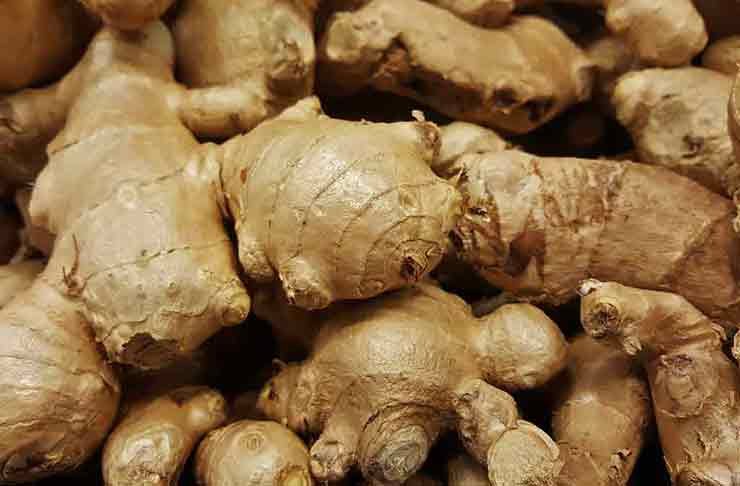
Rhizomes are used for cultivation of ginger. The seed rhizomes must be whole, free of pests and diseases. They must not be treated with chemicals as the treatment affects the growth. In addition, the ginger thus grown cannot be called ‘organic’ ginger.
Some of the high yielding improved varieties of ginger are Suruchi, IISR Mahima, Suprabh and IISR Varada. These were developed at Indian Institute of Spices Research (IISR), Calicut. Other high yielding local varieties are Wayanad local, Thingpui, Karakkal, Anamika, Amaravathi, Valluvanad, Jugijan and Zahirabad.
Local Cultivars of Ginger
| Cultivar | Characteristics | Disease resistance |
|---|---|---|
| China |
| |
| Assam |
| |
| Maran |
| Less susceptible to rhizome rot and leaf spot. |
| Himachal |
| Less susceptible to rhizome rot |
| Nadia |
| Less susceptible to leaf spot. |
| Rio de Janeiro |
| Tolerant to shoot borer. |
Improved Varieties of Ginger
| Variety | Characteristics | Suitable For |
|---|---|---|
| IISR Varada |
| All ginger growing areas of India |
| Suprabha |
| Orissa |
| Suruchi |
| Orissa |
| Suravi |
| Orissa |
| Himagiri |
| |
| IISR Mahima |
| Kerala |
| IISR Rajatha |
| Kerala |
| Athira |
| Humid, warm tropics |
Water Requirement in Ginger Farming
If ginger is being planted in a rain-fed area, nature would take care of the watering schedule. However, the soil must be checked regularly. It is necessary to ensure that there is no water logging in the soil. In case of irrigation the supply must be regular and not discontinuous. At the time of irrigation, continuous and careful monitoring is needed so as to prevent water stress in the crop or sunburn in the newly developed shoots. Too much water would also cause wilting which would in turn affect the final yield.
When the temperatures reach 31⁰C, irrigation must be started. The young shoots are at risk of sunburn when the shade temperatures go beyond 32⁰C. This is most likely to occur between 10 AM to 3 PM. During irrigation, ensure that only the top 2 cm soil is wet. The soil must be checked for moisture content regularly especially on still days when there is no wind.
Land Preparation in Ginger Plantation
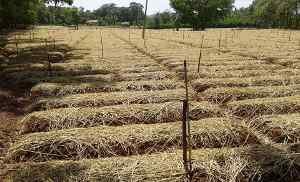
Land for ginger planting must be dug thoroughly and ploughed 4-5 times. This is typically done when the initial pre-monsoon showers set in. In some places, the surface soil is burnt as it helps rid of pests if any. In addition, it makes the soil more porous and healthier for ginger cultivation. Digging and ploughing ensures that soil is well-suited for sowing the rhizomes. For rain-fed crops, beds of 15cm height and 1m width are dug. The length can be as per convenience. A space of about 50cm is maintained between the beds. In case of irrigated crops, ridges are made in the soil at a distance of 40cm.
Solarisation
Solarisation is done primarily to get rid of the nematode infestations and rot disease. This step is not required if the surface soil is burnt. If there is no burning, then solarisation is recommended. The beds are solarized using transparent polythene sheet for a period of forty days.
How to Plant Ginger
Since ginger is grown from its roots called rhizomes, seed rhizomes from previous harvest are carefully preserved. They are cut into small pieces of 5cm length. Each piece must have one or two good buds for growth. The yield varies from region to region. It may be 600-700 kg/acre in Kerala while 800-1000 kg/acre in higher altitudes. The bits of rhizomes are treated with 0.3% mancozeb (3g per litre water) for half an hour, dried under shade for 3-4 hours and then planted. Drying must be done under shade else the rhizomes would dry up. The pieces are then planted in shallow pits, covered with rotten farmyard manure and soil. At the time of sowing a gap of 20-25cm must be maintained between the rhizomes.
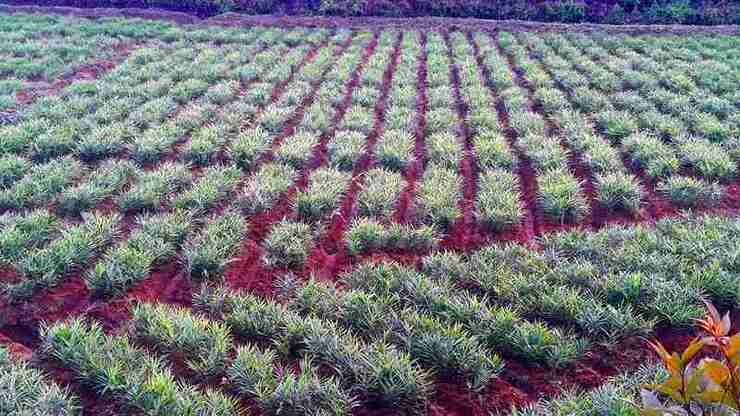
Plant Protection
After sowing, till the plants grow, ginger is susceptible to different diseases and infections. Utmost care and monitoring is necessary at this stage. Here are some of the diseases and pests that affect the growth of ginger.
Soft Rot
It is the most destructive disease in ginger farming in India affecting the ginger crop.
Causative Agent
Pythium aphanidermatum. P. vexans and P. myriotylum
Nature of Damage
It is a type of fungal infection caused due to the moisture content in soil. The fungus builds up along with the soil moisture especially during the monsoons. Young sprouts are the more susceptible ones. The collar region of the pseudostem affected by soft rot becomes water-soaked. The rotting spreads reaching the rhizome. The rhizomes grow soft and begin rotting and hence the name ‘soft rot’.
Symptoms
- Affected region becomes water soaked
- Middle portion of leaves are green while margins turn yellow.
- Yellowing spreads upward as well as downward to other regions.
- Pseudostems dry and wither
- The infected shoots are very easy to pull out from the soil.
Spreading of Disease
- Spreads through rhizomes
- Affected spores present in soil
Control
- The most important step here is to select soil that does not hold water. Soil must drain off water quickly.
- Seed rhizomes must be chosen from disease-free gardens.
- They must be soaked in 0.3% mancozeb for 30 minutes before storage and planting.
- The affected clumps must be removed as soon as the disease is detected. Then the surrounding areas must be drenched with mancozeb (0.3%) to check the spread of the disease.
- Applying Trichoderma harziamum with neem cake would help in preventing the spread of the disease.
Bacterial Wilt
It is a soil and seed borne disease occurring during southwest monsoon.
Causative Agent
Ralstonia solanacearum
Nature of Damage
The plant yellows and wilts severely. This is because the bacteria are focused around the vascular tissues in such high concentration that the vascular systems of the plant get blocked. As a result, the plants are deprived of nutrients and water from the soil. This affects the growth and development of plant ultimately resulting in its death.
Symptoms
- The green leaves start curling owing to the water accumulated due to blockage.
- The collar area of the pseudostems show presence of water spots that spread upwards and downwards.
- Lowermost leaves start yellowing and move progressively upwards.
- Leaves appear golden yellow in colour.
- There are dark streaks on the affected pseudostems.
- When pressed gently, a milky secretion oozes out from both rhizome and pseudostem.
Spreading of Disease
Being a soil and seed borne disease, it spreads through soil. The disease being more prevalent during monsoon, there should be no water logging in the soil.
Control
- The seed rhizomes must be free of diseases.
- They must be treated with streptocycline for half hour before planting and dried under shade.
- The beds must be drenched with 1% Bordeaux mixture or 0.2% copper oxychloride the moment the disease is noticed.
Leaf Spot
As the name suggests, the disease causes water-soaked spots on leaves.
Causative Agent
Phyllosticta zingiberi , Helminthosporium, Colletotrichum, Pyricularia, etc.
Nature of Damage
The leaves of the plant develop water-soaked spots which later turn white. The lesions enlarge and coalesce forming necrotic areas.
Symptoms
- Water spots appear on the leaf which gradually turns white with a yellow halo and dark brown margins.
- The spots then spread, coalescing forming necrosis.
Spreading of Disease
The disease spreads through the water splashes caused during intermittent showers. This incidence is severe in case of ginger grown under exposed conditions.
Control
Spraying the crop regularly with 1% Bordeaux mixture or 0.2% mancozeb can help control the disease.
Nematode Pest
There are nematode pests that cause root galls, rotting, lesions, root knot, burrowing, etc. in ginger. They cause rhizome rot and thus a heavy loss to the crop.
Causative Agent
Meloidogyne spp., Radopholus smilis, Pratylenchus spp.
Nature of Damage
They cause root galls leading to rotting of the plant around the roots. The infestation of nematodes also leads to rhizome rot.
Symptoms
- Necrosis of leaves
- Stunted growth of the plant
- Chlorosis of leaves
- Brown, water soaked areas are seen among the infected rhizomes
Control
Using seed rhizomes free of infection is the safest and easiest way to avoid nematode infection. At places where the chances of nematode infection are high nematode resistant variety IISR Mahima can be cultivated. In case of nematode infection, other measures include:
- Treating the infested rhizomes with hot water for ten minutes.
- Solarization of beds for 40 days/
- Biological control agent Pochonia chlamydospora can be included in the ginger beds during the sowing period.
Shoot Borer
It is a very serious infection in ginger which causes holes in the pseudostems. It more prominently occurs during September-October months and reduce the yield in ginger farming.
Causative Agent
Conogethis punctiferalis
Nature of Damage
The larvae of the insect drill a hole into the pseudostem of ginger and feed on the tissues on the inner side of the pseudostem. This results in yellowing and drying of the leaves.
Symptoms
- Presence of a hole on the pseudostem through which there is extrusion of frass.
- Yellowing and withering of central shoot.
Identification of Insect
- Light brown-colored larvae with scanty hair.
- The adult moth is medium-sized.
- Its wings are orange-yellow in color with tiny black-colored spots
Control
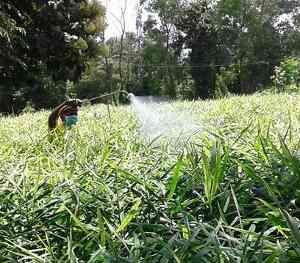
Spraying 0.1% malathion during the months from July-October every 21 days would take care of the pest. Spraying must be done as soon as the first symptoms are seen on the top leaves. Another strategy is to prune the leaves and destroy the freshly infested pesudeostems every two weeks beginning from July-August.
Rhizome Scale
Like turmeric, ginger is also affected by rhizome scale.
Causative Agent
Aspidiella hartii
Nature of Damage
The pests causing rhizome scale affect the rhizome in the later stages of growth and during storage.
Symptoms
- Plants are pale, devitalized and wither away leading to complete drying of the plant.
- Buds and rhizomes shrivel and ultimately dry up if the attack takes place during storage.
Identification of Insect
Adult scales are circular in shape and brown to grey in color.
Control
Seed rhizomes must be treated with 0.075% quinalphos for at least twenty minutes before storing. This process can be repeated in case infestation is detected at the time of sowing. However, severely infested rhizomes must be discarded as soon as they are detected.
Harvesting
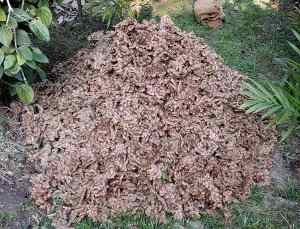
Ginger crop generally takes eight months for harvesting. It is ready when the leaves start yellowing and gradually drying. The ginger clumps are lifted carefully from the soil. The rhizomes are separated from the leaves and the roots and soil adhering to it is cleaned.
Duration of ginger crop is 6-8 months. In case of vegetable ginger, harvesting is done after six months while harvesting is done after 8 months of planting for dry ginger.
Curing of Ginger
After harvesting the rhizomes are washed in water and sun-dried for one day to obtain fresh vegetable ginger. For obtaining dry ginger, the process followed is:
- Rhizomes are soaked in water for eight hours.
- They are rubbed to clear the extraneous particles sticking on the surface.
- They are once again immersed in water for a few minutes and then removed.
- The outer skin of the ginger rhizomes are scraped out carefully. It should be done lightly because deep scraping can result in Damage of oil cells that are situated just below the outer skin.
- Peeled rhizomes are once again washed and sun-dried for one week.
- The dry rhizomes are rubbed against each other for the last time to get rid of loose skin cells and dirt if any.
Fresh ginger 20-25% of dry ginger- however it depends on the variety and place of cultivation.
Storage of Seeds
Seed rhizomes must be stored in pits under shade to ensure good germination for the next cycle. Healthy rhizomes are selected immediately after harvest. Generally, such clumps are marked in the field when they are 6-8 months old. The rhizomes are treated with 0.075% quinalphos and 0.3% mancozeb for half an hour and then dried under shade. They are then stored in pits dug in shaded areas. The wall of the pit must be coated with cow dung. The rhizomes are placed in the pits in the following manner:
- One layer of Rhizomes
- One layer of sawdust of about 2cm thickness
Both the layers are alternated with each other till the pit is 3/4th full. 1/4th area at the top is left empty to provide space for aeration. The pits are then covered with planks. The seeds must be checked once in every two weeks for infections. Shriveled, diseased rhizomes must be removed.
Commercial Viability of Ginger Farming
Ginger farming- organic or non-organic is commercially viable and profitable if you know how to grow ginger and take care of it. The cost of cultivation for ginger (organic) is approximately 44,000/- per acre. For non-organic farming the cost may go upto 65000/-. At the time of selling, its farm gate cost is 8/- per Kg. However, this price varies on yearly basis.
International Scenario in Ginger Farming
Globally, India and Indonesia are the largest producers of ginger. India produces 885.33 thousand tons of ginger annually. Statistically, it produces 23% of world’s ginger production.
Reference

Hi! I want to grow ginger at my farm in Punjab. Kindly let me know the economics of ginger farming.
You may buy our detailed project report for economics.
Growing Ginger in 1 year old arecanut land is good or bad?
M ginger farming kerna cahta hi
Sir,
I want to grow ginger at my farm in Bihar Kindly let me know the economics of ginger farming.
Ginger plantation is a good farming system which I want to do as I’m preparing myself.
which implements can be use for planting,harvesting and plant protection of ginger farming.plz guide.